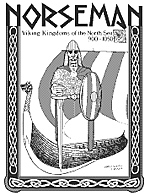
Introduction
Everyone has a picture in their minds of the Viking berserker, the blond, pale skinned giant in helmet and furs, a huge battle axe over his head. But this image is only part of the story. The Viking period covered in Norsemen! was a time of great change. The Northern European countries were conglomerations of villages, Jarldoms and petty kings, each owing some nominal degree of loyalty and support to a High King. But the High Kings were growing stronger. Increasing populations and wealth were giving them power, and power always strives for more. For over 100 years the related noble families of these contesting powers attacked and counterattacked. And for a brief time one man, Cnut the Great, managed to unite the North. Norsemen! is a game of these events. The game can be played by 2, or 6, or 78, or any number in between.
Each holding is represented by an individually named and rated Jarldom. Leadership systems are central to the game and managing leaders essential for success. Raid, trade, incursion, levy and outright warfare are all covered. Norsemen! is the game of the real Vikings.
Components
1 8 page 8˝”x11” rulebook
1 22”x27˝” unmounted two-colour map
255 die-cut ˝”double-sided counters
Counter Manifest
8 England (dark grey)
11 Denmark (grey)
13 Norway (light blue)
11 Scotland (light grey)
7 Ireland (light yellow)
6 Wales (light pink)
6 Sweden (purple)
2 France (pink)
2 Germany (dark pink)
12 Neutrals (yellow)
49 Incursion markers (mustard)
1 Turn marker (white)
6 Number counters (white)
21 Navy (light blue)
40 Denmark, Norway & England Leaders (blue)
30 Scotland & Neutral Leaders (green)
15 Ireland & Wales Leaders (orange)
15 Sweden, France & Germany Leaders (red)
Comments
Norsemen! is a unique treatment of one of history’s most enduring stereotypes. Instead of focusing on the tactics of individual warriors charging into battle, however, the game presents a more strategic view. Individual warriors are important, but only as leaders of their nation’s armies, not as combatants themselves. Battles represent the conflicts between kingdoms, not the small raids for plunder so often associated with the Viking myth. This is a game more concerned with the nation-building decisions of kings and jarls than the exploits of boatloads of treasure-hungry opportunists. As such, it plays more like Third Reich than Squad Leader.
The components are typical of SimCan games. The counters are double-sided with a nice matte finish. The counter graphics are practically non-existent. Leaders and armies, the most numerous of the counters, are simply text titles with numbers representing the various game factors. The only units with any kind of illustrations are the king units (a small crown) and the boat units. The map is a clear representation of northern Europe and the British Isles as well as the Baltic and North Seas. Political divisions and bodies of water are blue, land masses are white and labels and landmarks (forests, swamps and hills) are brown. That is the extent of the terrain and colours on the map. I found the map rather unattractive, but it is a functionally accurate representation of the area involved.
One small irregularity does stand out: while throughout the rules the game is called Norsemen!, the cover shows the title as Norseman. Certainly not a game-breaking faux pas, but an interesting curiosity nonetheless [I claim full credit for creating a potentially valuable and collectible variant -ed].
Collectors Notes
Given the rather esoteric nature of the topic of Norsemen! it is perhaps not too surprising that its value on the collector’s market is marginal. Boone lists low, high and average prices of 3/12/8.25 at auction and 10/25/17.00 for sale.
Errata
Obviously the title. However, even this changed in the SimCan Newsletter announcements. In issues 11 and 12, it was Norsemen!, in issue 13 it became Viking! but in issue 14 it was back to Norsemen! and stayed there.
Steve Newberg says:
I rather liked this game. The object here was to display a point in time where economic systems were changing, and the underlying cultures were shifting with them. Within this upheaval, the players had to work diplomatic and military magic to become Canute, and unify the diverse Jarldoms that were cohesing into states, into a Kingdom of the North Sea. The game works best by far as a multiplayer. Leadership and planning ahead are critical elements. It was fun to design and the testers kept going back to it on low intensity Sundays.
Back to Simulacrum Vol. 3 No. 2 Table of Contents
Back to Simulacrum List of Issues
Back to MagWeb Master Magazine List
© Copyright 2001 by Steambubble Graphics
This article appears in MagWeb (Magazine Web) on the Internet World Wide Web. Other military history articles and gaming articles are available at http://www.magweb.com